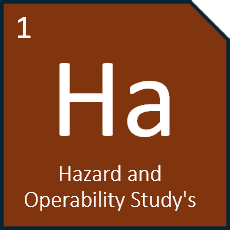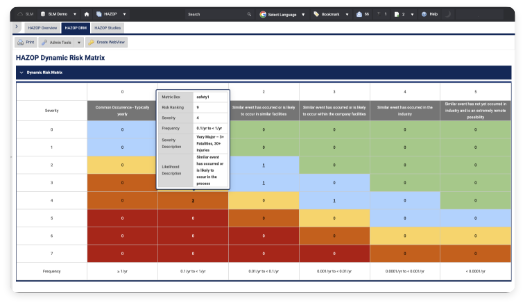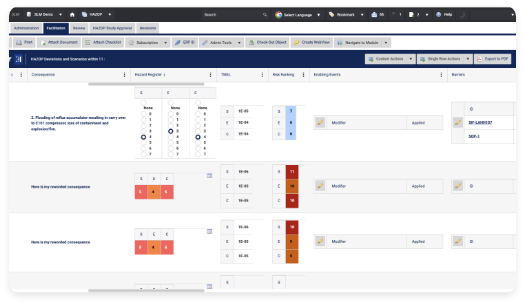
Identify risks before they become realities. The HAZOP Element provides structured tools to document, review, and manage hazard and operability studies in compliance with IEC 61511 standards.
What is HAZOP?
HAZOP (Hazard and Operability Study) is the first step in the Functional Safety Lifecycle. It is a structured and systematic examination of complex processes to identify potential hazards, deviations, and operability issues that could lead to unsafe conditions.
Our HAZOP software module empowers teams to:
- Build and manage HAZOP worksheets and nodes
- Collaborate across disciplines in real time
- Record causes, consequences, safeguards, and recommendations
- Maintain traceability through versioning and approvals
- Generate reports for regulatory and internal compliance
IEC 61511 Alignment
HAZOP (Hazard and Operability Study) is the first step in the Functional Safety Lifecycle. It is a structured and systematic examination of complex processes to identify potential hazards, deviations, and operability issues that could lead to unsafe conditions.

HAZOP Benefits
- Save time with preloaded templates and auto-formatting
- Reduce audit risk with consistent documentation
- Enable real-time collaboration during workshops
- Link HAZOP results directly to LOPA and SIS design elements
Dynamic Risk Matrix
Real-Time Insight into Every Scenario
The SLM HAZOP Dynamic Risk Matrix brings your data to life—instantly visualizing how frequency, severity, and likelihood combine to define real-world process safety risks.
Teams can interact with live data, explore detailed scenario information, and focus attention where it matters most. Whether assessing current operations or planning future improvements, the Dynamic Risk Matrix turns complex data into clear, confident decisions.
Facilitate with Clarity and Control
The SLM HAZOP Facilitation view gives your team a single, interactive workspace for managing every node, deviation, and scenario in real time. Risk rankings, guidelines, and consequence evaluations are all visible and editable in one dynamic interface—making study sessions faster, more consistent, and fully traceable.
From assigning severity and frequency to applying safeguards and barriers, SLM simplifies complex HAZOP reviews into an intuitive, collaborative process that keeps your team aligned and your analysis accurate.
Simplified Central Management of Causes, Consequences, and Deviations
Take control of your HAZOP studies with a centralized, easy-to-use interface that brings every Cause, Consequence, and Deviation together in one place.
The SLM HAZOP module streamlines how teams review and manage risk, providing instant visibility into hazard rankings, related nodes, and critical safety data. No more spreadsheets or scattered notes—just clear, connected insights that help your organization make faster, safer decisions with confidence.
Visualize Your Risk Across the Site, Unit, or Enterprise
Turn complex safety data into clear, actionable insight. The SLM HAZOP Inherent Risk Chart provides a real-time view of potential Safety, Environmental, and Commercial risks—helping teams instantly understand where hazards exist and how severe they are.
Track and Verify LOPA Progress with Confidence
The SLM HAZOP LOPA report provides instant visibility into which HAZOP scenarios require a LOPA and which have been completed—ensuring no gaps between analysis and action.
With a clear comparison of required versus performed studies, teams can easily track progress, demonstrate compliance, and drive accountability across units, facilities, or the entire enterprise.
Real-time insights make it simple to prioritize resources and maintain a proactive approach to process safety.
Build a Safer System from the Start
The SLM HAZOP LOPA report provides instant visibility into which HAZOP scenarios require a LOPA and which have been completed—ensuring no gaps between analysis and action.
BLOG & ARTICLES
Stories that Drive Innovation
Discover how our software solutions enable smarter decision-making, operational excellence, and compliance across the world’s most complex industrial environments.





